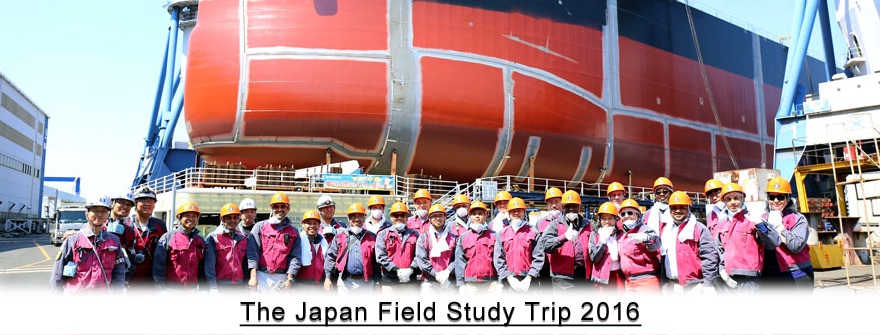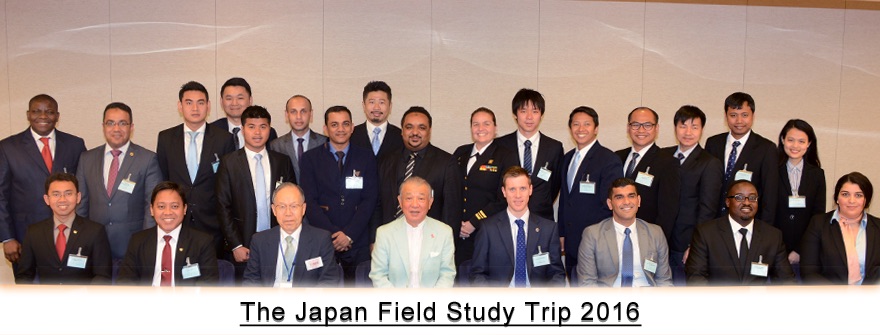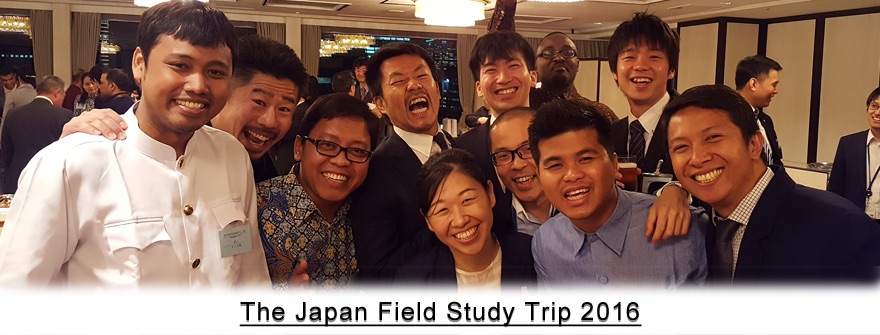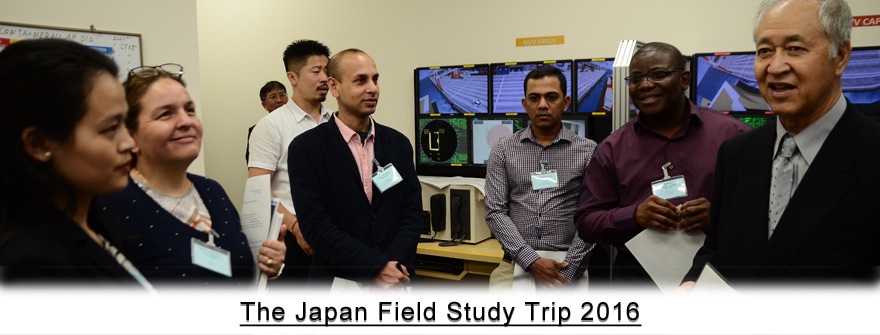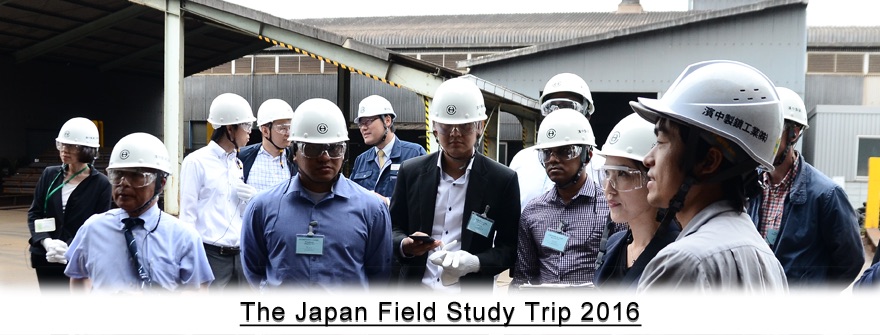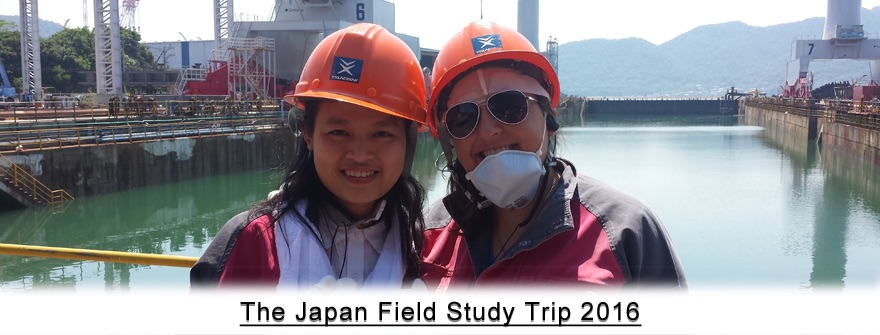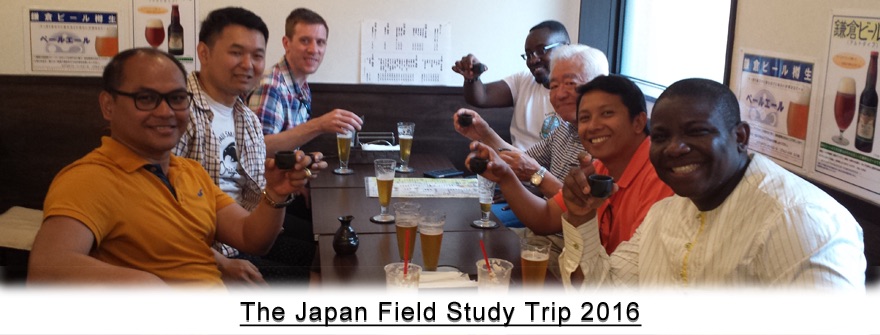Japan Field Study Trip
Japan Field Study Trip 2016
The Journey and Arrival: Saturday 14 Sunday 15 May
For the WMU Sasakawa Fellowship Programme students, the field studies trip to Japan is the highlight of their year. And so, 21 excited students arrived early at Malmö Centralen station to begin their journey. After many hours in the air, we glimpsed the landscape that would become a familiar sight; the ocean and mountains of Japan, as we came in to land at Kansai International Airport.At the airport, we were welcomed by a familiar face (and the camera lens) of Mr Shinichi Ichikawa from the Sasakawa Peace Foundation and the new face of Ms Miyoko Wada, who would be our trusty tour guide for the whole week. With our greetings and introductions complete, heads counted and bags loaded onto an air-conditioned coach, we set off to Kobe and to our hotel, which would be our base for the next few days. Kobe is a long and narrow coastal city, on a thin piece of land between the steep inland mountains and the waters of Osaka Bay; a beautiful place to begin our week.
At our hotel, we found another familiar face greeting us, this time, Mr Eisuke Kudo. After a brief orientation session we proceeded to a Welcome Reception, attended by senior representatives of the maritime industry and maritime academic institutions. Mr Anas Alamoush delivered a heartfelt address on behalf of the students. The reception ended with the students performing the WMU song, capping off a wonderful beginning to our week.
Ashiya, Himeji: Monday 16 May
Well rested and well fed, we left the hotel for our first site visit at the Marine Technical College in Ashiya, Kobe. We were welcomed there by former WMU Professor Toshio Hikima and received an introduction to the institution by the Rector, Mr Tanabe. We then enjoyed a tour of the facilities on campus, which included a range of different simulators.The afternoon was spent at the Hamanaka Chain factory in Himeji, Hyogo. Many students had expressed an excited interest, when seeing this location on the schedule and we were indeed given a fascinating tour, which gave us knowledge of the chain manufacturing process and an insight into an industry which supports maritime and offshore activities.
Fukuyama, Yamaguchi: Tuesday 17 May
An early start to the day, with a short walk to the Shin-Kobe station to catch the Shinkansen “bullet train” and with Ms Wada’s help we all board safely. Before too long, travelling at full speed and covering many kilometres southwards along the coast we are able to see more of the beautiful Japanese countryside.Our first stop of the day was the Tsuneishi Shipbuilding Company in Fukuyama, Hiroshima where we were given a very interesting tour of the shipyard. The students were able to see different stages of ship construction and were impressed by what they saw with regards to energy efficiency and safety on modern ships. Mr Sokhdara Srey found himself volunteered to take part in the ladder safety training, much to the amusement of his fellow students.
From Fukuyama we travelled further south on another Shinkansen to the very tip of the main island of Honshu, to the National Fisheries University, set in an idyllic location in a sheltered bay in Yamaguchi, Shimonoseki. After an introduction to the University and its different programmes of study by President Keiji Washio, the students received a detailed explanation of the Ministry of Agriculture, Forestry and Fisheries, under whose auspices the University runs. The students were grateful for an extensive question and answer session before a tour of the campus and facilities.
From Yamaguchi we travelled over the Kanmonkyo Bridge to the southern island of Kyushu to our new hotel in the castle town of Kokura.
Kitakyushu, Tokyo: Wednesday 18 May
As a visitor to Japan it is easy to forget that the country is so long from North to South, but the heat and humidity of the morning and the palm trees lining the roads on our way to our first destination served as a reminder of how far south we had come.The morning had a distinctly green theme. Our first visit was to the Port of Kitakyushu, Fukuoka. The lectures here provided a wealth of information and gave the students a fascinating insight into the remarkable transformation of Kitakyushu City, which is a global success story with regards to overcoming the effects of pollution. From here we travelled down the road to the Hibiki LNG Base, where after a short introduction we were given a tour of the facilities. We were fortunate to be taken onto the roof of the main building where we had a bird’s eye view of the entire site.
Our brief stay on the island of Kyushu was now over as we travelled to the airport to board a plane to Tokyo, which would serve as our base for the remainder of our stay in Japan. After landing at Haneda Airport, we took another air-conditioned coach into the centre of the city, taking in the buildings, bridges and public gardens of Tokyo on our way. At the other end we were rewarded by the sight of the Nippon Foundation building.
A mixture of excitement and nerves could be felt in the room as we patiently waited for the arrival of Dr Sasakawa. This was after all, the day the students had all been waiting for. The students were extremely happy that Dr Sasakawa was able to find time in his busy schedule to see them. Mr Henry Mwasaru delivered an address on behalf of the students, passionately speaking of the responsibility he and has fellow Sasakawa Fellowship Programme students have to serve the maritime industry and make the world a better place and thanking Dr Sasakawa for the opportunity to do so. Dr Sasakawa then addressed the students, speaking of his own philanthropic missions. Fortunately, we were able to squeeze in a short photo opportunity and the students were very happy to be able to exchange business cards and present Dr Sasakawa with gifts from their home countries.
Tachikawa, Machida: Thursday 19 May
Another early start and a bus ride out of the city to the Japan Coast Guard Research Center in Tachikawa, Tokyo. The tour of the facilities gave the students an appreciation of the wide range of specialist research undertaken at the center and they were grateful that in each area there were willing members of the research team on hand to answer their questions.From Tachikawa we then made our way to the Kawasaki Kisen Kaisha, “K” Line Training Center in Machida, Tokyo. The students were particularly excited about visiting such a major shipping and logistics company. Captain Eiji Kadono gave a welcome speech before lectures on the history and outline of the “K” Line Company and its seafarer education programme. A tour of the facilities followed and another extensive question and answer session. The students were particularly interested to hear the origin of the ship names.
MLIT, Tokyo: Friday 20 May
For our morning in Tokyo we were treated to some of the best views of the city from the dizzying heights of the Tokyo Skytree. While the clouds were not kind enough to grant us a view of Mount Fuji, some 120km away, we were treated to a fabulous view of the city and Tokyo Bay, down to Yokohama on one side and Chiba on the other.After lunch we made our way to the Ministry of Land, Infrastructure, Transport and Tourism in an area of Tokyo filled with government ministry buildings. Deputy Director-General, Mr Koichi Kato gave some opening remarks to the students, welcoming them to the Ministry. Mr Wynchester Florentino addressed the representatives of the Ministry, expressing thanks on behalf of the students. Then Mr Takenori Oka delivered an informative presentation on the structure of the Ministry and maritime policy in Japan. He was also able to answer some of the questions sent in advance of the visit.
Following our appointment at the Ministry we had just enough time to take in the beautiful Hamarikyu Gardens, former Imperial gardens now open to the public, before it was time to go to our Farewell Reception. This took place on the 35th floor of the Kasumigaseki Building, with a fantastic view of the city, including the iconic Tokyo Tower and as we looked down, even the Nippon Foundation building we had visited just days before. The week had gone by so quickly and this was a fitting end to our official field study programme, in the company of senior representatives of the Nippon Foundation, Sasakawa Peace Foundation, the Ministry of Land, Infrastructure, Transport and Tourism, members of the diplomatic corps, maritime industry officials and WMU graduates.
Mr Hiroshi Terashima, President of the Ocean Policy Research Institute at the Sasakawa Peace Foundation and former WMU Governor, opened the meeting before Mr Hiroaki Sakashita, Director-General of the Maritime Bureau at MLIT made a toast. A dinner buffet was served and Ms Fatima Zahra El Marzouki spoke on behalf of the students, thanking the hosts for the wonderful opportunity they had been given. The evening was rounded off by the energetic singing of the WMU song, for which the students were joined by the WMU graduates.
Kamakura: Saturday 21 May
With our official programme over, we had the opportunity to experience some cultural sites on our last full day. We travelled south, to the seaside resort town of Kamakura, Kanagawa on what happened to be a beautiful sunny morning. Our first stop was the Buddhist temple of Kotoku-in, which is renowned for its monumental large bronze Amida Buddha. We were not only impressed by the size of the Buddha but that it had survived many earthquakes and a tsunami!From Kotoku-in we made a short journey down the road to Tsurugaoka Hachimangu, a Shinto shrine in the centre of the city of Kamakura. Fortunately for us we had Ms Wada on hand to explain to us the significance of the different parts of the shrine and the sense of tradition was further enhanced by the fact there was a traditional wedding occurring that day. After spending some time within the gardens around the shrine we were able to explore the town, which was filled with souvenir shops and restaurants. And with the sun still shining, we made our way back to Tokyo; a perfect end to a perfect week.
Departure: Sunday 22 May
We left for the Narita International Airport early on the Sunday morning, feeling lucky to have spent the past eight days in this beautiful country. We had been to nine field study locations spread across six prefectures in a week. The variety of different site visits, the hospitality of our hosts and their generosity in sharing so much information with us, was truly appreciated. At each location we were welcomed and made to feel like friends. In each question and answer session the students received thoughtful and thorough answers to the many questions they had. The spirit of international cooperation we had experienced was a lesson in itself.Our thanks go to all the people that made this trip possible, the Nippon Foundation, the Ministry of Land, Infrastructure, Transport and Tourism and all our of field study hosts. But especially, our thanks go to those who were with us for the whole week, Mr Kudo, Mr Ichikawa and Ms Wada. A special mention should also go to our Japanese students, Mr Koki Matsushima, Mr Tomotsugu Noma and Mr Kazuya Shintani, who selflessly donated their time and local knowledge to make sure there were a variety a things for the students to do in the evenings when they were not engaged in official activities. They all helped to make sure we left with memories which will last a lifetime.
Peter Marriott
Assistant Registrar
World Maritime University
